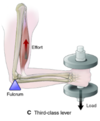PTA 102 Flashcards
Study Guide from board for mid term. (77 cards)
What is Newton’s Law of Inertia?
An object at rest tends to stay at rest, and an object in motion tends to stay in motion.
What is Newton’s Law of Acceleration?
The amount of acceleration depends on the strength of the force applied to an object.
What is Newton’s Law of Action-Reaction?
For every action, there is an equal and opposite reaction.
What is linear force?
Results when 2 or more forces are acting along the same line
What is a parallel force?
Occur in the same plane and in the same or opposite direction
What is a stabilizing force?
The force generated by the muscle is directed back into the joint, pulling the two bones together
- Example: biceps in nearly full elbow extension (i.e. - carrying grocery bags)
What is an angular force?
Movement force; most of the force generated by the muscle is directed at rotating, not stabilizing the joint
- A muscle is most efficient when the joint is at or near 90 degrees.
First-Class Lever
- Axis is located between the force and the resistance
- Advantage: Force
- Disadvantage: Poor range of motion and speed
- Ex: Crowbar, can opener, scissors

Second-Class Lever
- Resistance is in the middle, with the axis at one end and the force at the other
- Advantage: More powerful than first-class lever
- Disadvantage: Less range of motion and speed
- Ex: Wheelbarrow, nutcracker, bottle opener

Third-Class Lever
- Force is in the middle, with resistance and the axis at opposite ends
- Advantage: Speed and distance
- Disadvantage: Less force
- Ex: Baseball bat, tennis racket, golf club

Center of Gravity (CoG)
The balance point of an object at which torque on all sides is equal; the point at which all planes of the body intersect
Base of Support (BoS)
The part of the body that is in contact with the supporting surface
Line of Gravity (LoG)
An imaginary vertical line passing through the CoG toward the center of the earth
Tissue Types
- Epithelial tissue - skin and organ linings
- Muscle - contractile tissue
- Nerve tissue - generates and conducts electrical signals
- Connective tissue - EVERYTHING ELSE!
Properties of Soft Tissue
- Stretch (lengthen without being injured or damaged)
- Elasticity (ability to recoil or rebound to an original length of shape after being stretched)
- Plasticity (capacity to be altered and retain that new configuration)
- Creep (gradual change in shape that occurs when tissues are subjected to a slow, continuous force)
- Thixotropy (responds to changes in temperature - or other disturbances such as pressure - by transforming from a gel to a liquid - or solid - and vice versa)
- Tensile strength (ability to be pulled in two different directions without damage, can withstand tension)
- Piezoelectric effect (when dense connective tissue is subjected to mechanical stress, its molecules shift and an electrical charge is produced)
- Colloidal (composed of solid particles suspended in fluid so that it is both flexible and virtually incompressible

Functional Classifications of Connective Tissue
- Compression tissues - bone and cartilage
- Tension tissues - proper fascia, tendons, and ligaments
Two Sections of the Skeleton
- Axial skeleton: Head, thorax, and trunk
- Appendicular skeleton: Attaches to the axial skeleton; extremities

Long Bones
- Largest bones in the body
- Make up most of the appendicular skeleton

Short Bones
- Tend to have more equal dimensions of height, width, and length
- Great deal of articular surface
- Usually articulate with more than 1 bone

Flat Bones
- Very broad surface
- Not very thick

Irregular Bones
- Have a variety of mixed shapes

Sesamoid Bones
- Resemble the shape of sesame seeds
- Small bones located where tendons cross the ends of long bones in the extremities

What is Wolff’s Law?
Bone tissue, when put under stress, will thicken and form a stronger osseous matrix, and, when stress is removed, unused material will be reabsorbed
Fibrous Joints
3 Types:
- Synarthrosis - suture joint (skull bones)
- Syndesmosis - ligamentous joint) between radius and ulna as well as distal tibiofibular joint)
- Gomphosis - “peg-in-socket” (teeth in their sockets)






















